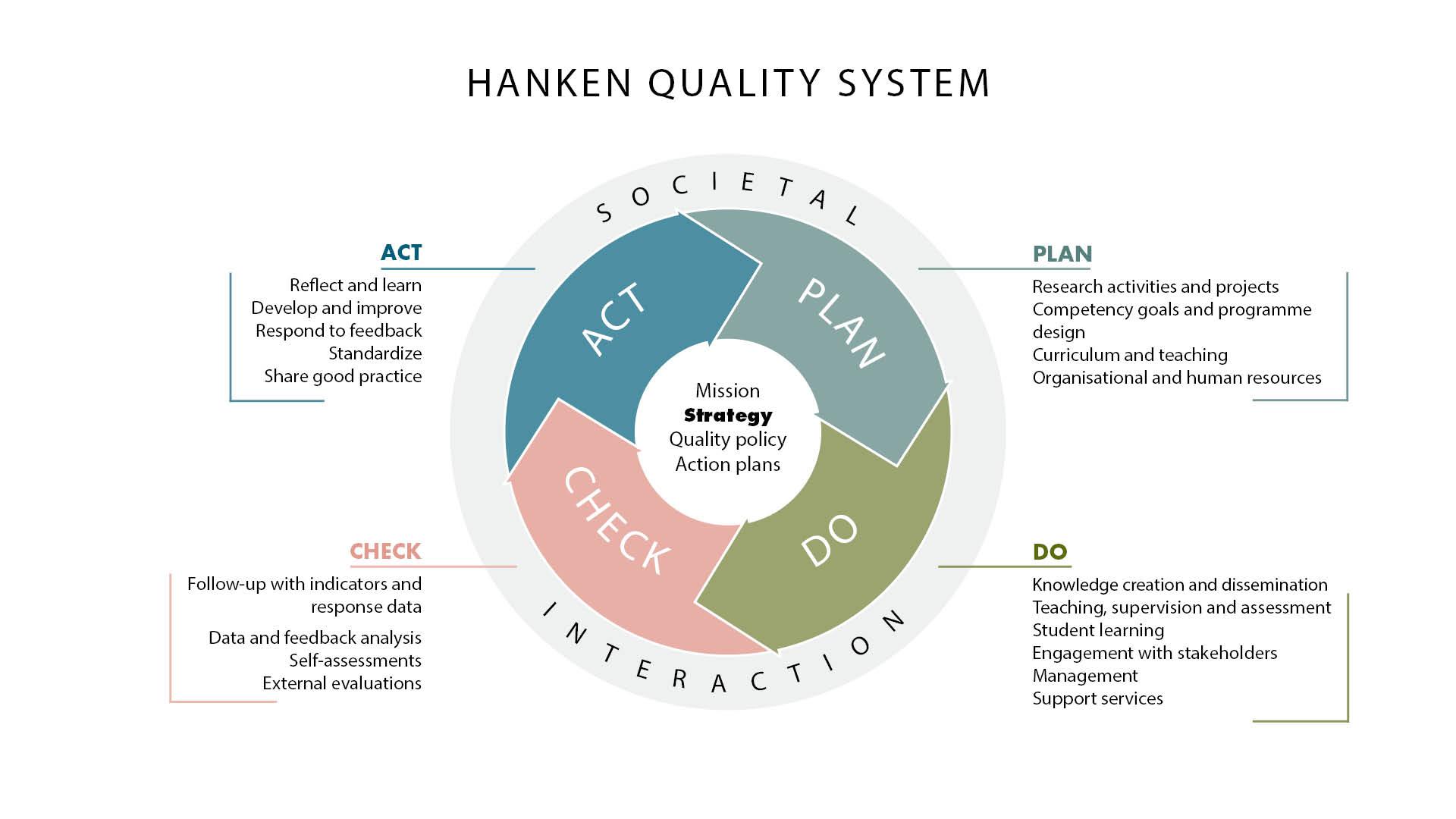International accreditation schemes have a clear impact on Hanken’s quality system
Hanken’s quality system is safeguarded by various roles and functions: The management level of the university, i.e., the rector, deans, heads of departments, the language centre director, directors of the administrative offices, are responsible for implementing the necessary procedures in their respective areas of responsibility. The dean for programmes and quality assurance supervises the system and chairs the Committee for Assurance and Learning and Quality. This dean is supported by a quality assurance team, also supporting her in handling external quality assessments. The audit team was informed during the audit visit that the roles of deans had been reconsidered and recruitment for the new positions was ongoing. Other bodies involved include the Academic Council which coordinates quality work across research and education, approves the quality policy and holds responsibility for the Assurance of Learning Process; the Education Council for quality which coordinates aspects related to teaching and learning; and the various department councils which coordinate other aspects. The quality assurance of research and societal impact are less prominently featured in the official role descriptions. For an organisation of a rather modest size, Hanken’s responsibility structures regarding quality (management) appear to be quite complex, at least on paper, with some overlaps and a certain meeting-heaviness. The structures seem to be well accepted, though, and to a large degree effective.
Hanken’s principles and efforts regarding quality are outlined in a quality policy and quality handbook, which is publicly accessible on Hanken’s website. The audit team also found a clear-cut and transparent narrative on the quality system, which is dominated by the Assurance of Learning process. The various international accreditations (EQUIS, AACSB, AMBA), which provide Hanken with a certain elite status in the sector of global business schools, are a big part of this narrative too. Both the documentation and the interviews show the impact of the accreditation schemes on the quality system and the need to comply with the standards of the international accreditations. This is visible, e.g., in the strong focus on the AACSB-derived Assurance of Learning and how the international accreditation seals are invoked to demonstrate Hanken’s quality. This is not to say that the quality system is entirely compliance-oriented and only driven by the ambition to maintain the national and international quality seals: The audit team found a strong and clearly visible quality culture at the university, with actors on all levels demonstrating their willingness and ability to identify problems and act upon them; in other words, a palpable degree of improvement-orientation.
The alignment between the quality and management systems could be further strengthened
The culture of improvement-orientation and the quality processes in place allow Hanken to deal with short-comings, albeit in a rather reactive way. The evidence available for the audit team made it difficult to assess how what Hanken describes as its quality system supports evidence-based strategy development and strategy implementation. For the latter part, there appears to be robust structures and procedures in place for cascading the overall strategic objectives, e.g., action plans, annual meetings between the rector and the departments, even if during the audit visit these remained partly outside of the quality system narrative. In addition, quality management cycles for research, innovation and development as well as for societal engagement and impact appear to be less developed than for the area of education. There are effective elements to build upon, yet also a certain need to systematise. The audit team suggests for Hanken to work on a stronger alignment of its quality and management systems. This entails the way the systems are presented on the website, in reports, in the quality manual as well as in practice, e.g., having quality management instruments visibly feed into annual planning and strategy development.
Most interviewees during the audit visit were able to cite the strategy and showed a keen awareness of institutional strengths and priorities. According to the interviews, making sense of the strategic objectives and how they are tackled varied considerably across the university—which has clear advantages (e.g., acknowledging disciplinary differences, ensuring buy-in). However, as mentioned in other places in this report, the university needs to ensure that minimum standards are safeguarded and regularly reflected on. It did not become clear to the audit team to what degree the current strategic objectives challenge Hanken and move it forward – and to what degree it might be enough to link existing activities to them. Evidence from the interviews and documents suggest both approaches can and do exist in parallel. The need for stronger system level reflectiveness will be taken up in section 3.3 of this report.
